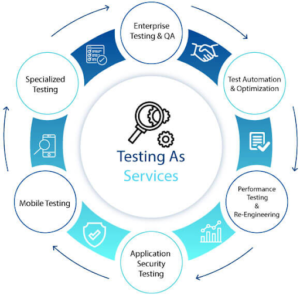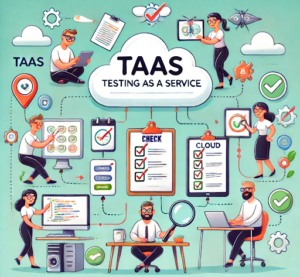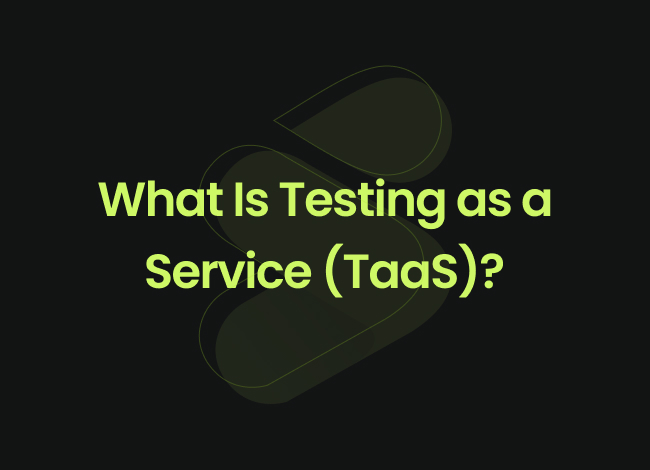Introduction:
In today’s evolutionary process of software development, Testing as a Service (TaaS) is an essential factor. This approach includes different types of testing, all of which are oriented to increase the quality of the software produced. Widening its scope throughout the years, TaaS now encompasses many forms. In this article, we will go over “what is testing as a service” and the types of TaaS that currently exist as well as some of the advantages they offer. So, stay with us to dive in the ocean of TaaS testing.
What Is Testing as a Service (TaaS)?
“Testing as a Service (TaaS) represents an innovative approach to software quality assurance by outsourcing testing activities to a specialized service provider.”

TaaS services as a relatively new model of software quality assurance implies outsourcing of testing functions to a third-party vendor. Primarily, TaaS utilizes cloud-based solutions to enable business organizations to acquire a complete range of testing services as required. It allows for getting used to the core functionality, having expert assistance, and provision of testing environments.
As it has been highlighted earlier, TaaS solutions enable organizations to choose the kind of outsourcing that is suitable for their requirements. Some of the organizations are fully outsourcing their tests or hiring the third-party provider, other organizations outsource only some of the tests while some tasks are being performed internally depending on the organization’s needs and preferences.
How Does TaaS Testing as a Service Work?

Testing as a Service works on a model whereby clients put down a subscription fee or are billed on the basis of usage of testing services. The Testing as a Service model lets businesses use testing tools and experts anytime they need, without having to own or manage them. Here’s a general overview of how it works:
Assessment of Requirements: Thus, the TaaS provider starts with the evaluation of the testing needs of the given organizations. This entails knowledge of the extent of work to be done as well as the kinds of test, the time requirements.
Provisioning of Testing Environment: The provider prepares the testing environment in terms of hardware, software, and networks and in most cases involves use of cloud.
Execution of Testing: Carrying out of the agreed upon tests using automated and/or manual testing method constitutes the TaaS provider. They embrace state-of-the-art tools and technologies to make sure all the requirements are tested.
Reporting and Analysis: Finally, once the tests are run, the provider prepares the report including the rundown of the defects, poor performance and other problems. It also offers suggestions and directions on how enhancement of the quality of the application might be attained.
Ongoing Support and Maintenance: Based on the type or form of engagement, the provider may provide consultative services beyond the fixes, which include retesting, regression testing and constant monitoring among others.
Types of Testing as a Service
Functional Testing:
Checks if each part of a software application works as it should. It makes sure that all features perform correctly both on their own and when used together.
Performance Testing:
Measures how well the software performs under different conditions. It helps find out if there are any slowdowns or issues that need fixing.
Security Testing:
Looks for weaknesses and potential security threats in the software to protect against hacks and unauthorized access.
Compatibility Testing:
Ensures that the software works properly on various devices, browsers, and operating systems, providing a consistent experience across different platforms.
Usability Testing:
Evaluates how easy and user-friendly the software is. It checks if the application is simple to navigate and meets user expectations.
Load Testing:
Tests how the software handles the expected number of users and activities. It helps identify any issues that might occur under normal usage levels.
Stress Testing:
Examine how the software performs under extreme conditions or heavy loads to find out where it might break or fail.
Regression Testing:
Ensures that new updates or changes don’t break existing features. It checks that everything still works correctly after modifications.
Automation Testing:
Uses automated tools to run tests, making the process faster and more consistent. It’s especially useful for repetitive or large-scale testing.
Mobile App Testing:
Focuses on testing mobile applications across different devices and screen sizes to ensure they work well and look good on all types of mobile devices.
The Benefits of Testing as a Service
This paper seeks to explore testing as a service and the benefits that come with it. Advantages of Testing as a Service (TaaS) include saving money and gaining more flexibility. By using TaaS, companies can avoid the costs of running their own testing teams and equipment.
1. Cost-Efficiency
Another advantage associated with testing as a service lay in aspects that do concern cost optimization. TaaS providers have their own infrastructure and human and material resources, which means that the businesses do not have to invest in costly testing tools, test environments, and skilled testers. The fact that the pay as you go model means that firms only incur costs that directly relate to the facilities they require, it cuts on cost which is incurred in such features.
2. Scalability
TaaS providers offer unmatched scalability. During one’s busy hours or large project, a business may find it useful to scale up and test more, and TaaS arrangements allow them to scale down just as easily during slow periods. This is especially important for short and medium term businesses, where the organization cannot afford to have a dedicated testing team right from the start. It is one of the main Testing as a Service benefits.
3. Faster Time-to-Market
As with TaaS solutions, the testing phase can be performed faster and without great difficulties, and, therefore, the time-to-market for new products and updates may become shorter. This speed is very important today when getting in first place means a lot in today’s world.
4. Focus on Core Competencies
Thus, outsourcing testing to a TaaS provider allows the organization to concentrate on the fields in which it has expertise and competitive advantage, such as development, marketing, and customer service, instead of worrying about the intricacies of testing. One of the main Testing as a Service benefits is getting high-quality testing with the latest technologies and expertise, helping improve software quality efficiently.
These are some benefits of testing as a service. At Siznam advantages of Testing as a Service (TaaS) include cost savings and enhanced flexibility and many more.
Common Use Cases for TaaS

TaaS is highly versatile and can be applied in various scenarios, including:
Agile Development:
TaaS enhances the possibility of testing in an Agile situation since it persists with the Agile testing concepts of sustaining the velocity of development.Cloud-Based Applications: Cloud-based testing as a service can also be recommended for provision of testing cloud based applications since it has the ability to change depending on the loads. Siznam is the only platform at which you can use cloud-based testing as a service effectively.
Compliance Testing: The strict regulatory matters like the finances sector and healthcare sector can use TaaS to meet all the regulatory measures in place.
Cross-Platform Testing: TaaS can be applied to find out if an application is suitable to run on other systems, and if it is capable of running on different testing as a service companies, different devices as well as different operating systems.
Challenges and Considerations
While Testing as a Service offers many benefits, it’s essential to consider some potential challenges:
1. Data Security:
Testing that is outsourced, especially for business applications and critical applications can instigate questions on how secure the data is. To this end, organizations must make sure that TaaS platforms meet very high standards of security.
2. Integration with Development Processes:
TaaS platform can be integrated to a development and DevOps flow rather easily; therefore, one of the major issues arises from the ability to consider it a part of the process without huge differences from existing ones. Substantial understanding and cooperation with the clients’ in-house team and the TaaS provider are essential.
3. Dependency on Providers:
Outsourcing arrangement also suggests that there may be problems when the provider experiences some difficulties or if there are changes made with the services that the provider company offers to the outsourcing business firm.
Conclusion:
Testing as a Service (TaaS) is a new business model that holds promises to straighten businesses tasked with improving software quality, yet within constrained budgets and time horizons. Thus, TaaS services are to become indispensable for further successful software development and quality assurance amid the growing customers’ demand for superior-quality applications.
Testing as a service companies such as Siznam are currently leading in offering such solutions that enable organizations to be relevant in today’s digital economy. TaaS solutions can be extensively adopted by adopting Siznam; a method that helps provide the best software solutions without dealing with the in-house testing team hassle. The Testing as a Service model allows businesses to use testing tools and experts whenever they need them, without having to buy or look after these resources on their own. This is a powerful and comprehensible approach to addressing today’s testing issues, making TaaS a critical component of the software development life cycle.






